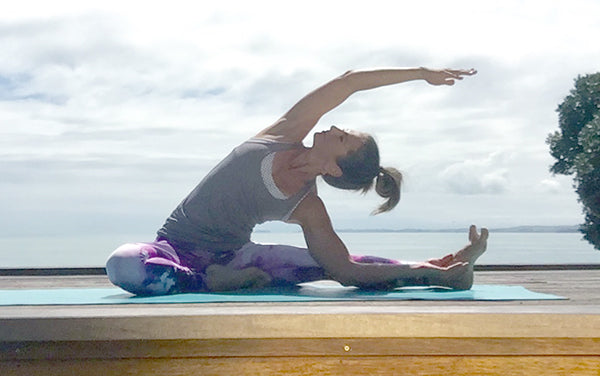I came to yoga as a competitive athlete, trying to stretch out my tight runner's hip flexors and to calm my overly competitive spirit. From the beginning I loved the physical challenge of the poses and I left that very first class feeling, lighter, taller and more at peace with myself. Unlike many other forms of training, the practice of yoga unfolds over time to reveal many layers of physical benefits and personal revelations.
More and more people are discovering the many ways yoga can be used to improve athletic performance—from increasing mental concentration and improving flexibility and balance to preventing common injuries and honing skills in a particular sport.
Whether by creating an entire training program for elite athletes or by simply integrating a few yoga poses into an existing fitness routine, I utilise yoga as an effective cross-training tool. I've found that yoga helps athlete clients, fitness fiends and weekend warriors to feel, perform and live with more ease and increased energy.
Running
I know from experience that runners pound and hammer their bodies on different hard surfaces, resulting in injury or overuse to the muscles and tendons of the legs, feet, hips and lower back. One of the best yoga poses for runners is eka pada rajakapotasana prep (pigeon pose prep) which stretches many muscles, including the hip flexors, the gluteals and the piriformis, psoas, lower back and groin muscles. Also good for runners are any lunging poses that lengthen the achilles tendon and soleus muscles—for example, the low lunge. To deeply stretch the hamstrings, the best choice is parsvottanasana (intense side stretch pose).
[caption id=“attachment_6185” align=“alignnone” width=“300”] Eka pada rajakapotasana prep (pigeon pose prep)[/caption]
Eka pada rajakapotasana prep (pigeon pose prep)[/caption]

Low lunge

Swimming
Swimmers tend to have a strong front body and often encounter shoulder problems. Rotator cuff injuries or shoulder tendonitis (also called ‘swimmer's shoulder') occur when the rhomboids are not held in place when the arm is raised in the freestyle stroke. Instead of the muscle carrying the weight of the arm, the tendon bears the burden. Over time the tendon becomes frayed and aggravated. In adho mukha svanasana (downward-facing dog) and urdhva mukha svanasana (upward-facing dog), your instructor may tell you that the shoulder blades need to drop down the back - the same principle as swimming. Baddha konasana (bound angle pose), demonstrates a healthy external rotation of the hip. For many people, though, the hips remain locked and stiff. In a swimmer, this congestion can manifest in a faulty breaststroke kick. Hero pose (virasana) is also very good for swimmers' ankles, helping the foundation of the kick.

Downward-facing dog

Upward-facing dog

Baddha konasana (bound angle)
[caption id=“attachment_6191” align=“alignnone” width=“300”] Hero pose (virasana)[/caption]
Hero pose (virasana)[/caption]
Golf
Golfers need to repeatedly twist their body in one direction to swing a golf club. Mastering the sport of golf requires tremendous strength in the entire torso. To strengthen and flex the spine, try utthita parsvakonasana and bhujangasana (cobra pose). Golfers can also gain strength, flexibility and stability by doing twisting poses, such as ardha matsyendrasana (pretzel pose).

Utthita parsvakonasana

Bhujangasana (cobra pose)

Ardha matsyendrasana (pretzel pose)
Skiing
Skiers often incur injuries in their low back and knees. Skiers also tend to have over-developed quadriceps and weak/tight hamstrings. These conditions can be improved by doing poses that strengthen the joints and muscles of the low back, knees and posterior legs. Examples to try are modified virabhadrasana (modified warrior pose with hands floor or blocks), paschimottanasana (seated forward fold pose), supta padangusthasana prep (supine hand-to-big-toe pose prep) and bhujangasana (cobra pose), the last of which is above.

Modified virabhadrasana (modified warrior)

Paschimottanasana (seated forward fold pose)

Supta padangusthasana prep (supine hand-to-big-toe pose prep)
Tennis
Because of the demands of tennis, players often lose their suppleness in the back and torso and deplete the strength in their shoulders, elbows and wrists. Prasarita padottanasana (legs spread wide, forward bend while standing) is excellent for opening the shoulders; it also deeply stretches the hamstrings and adductors. Other good choices for tennis players are utkatasana (chair pose), which strengthens the abdominal muscles and stretches the achilles tendon, calves and spinal column, and virabhadrasana 2 (warrior 2 pose), which builds strength and balance, especially in the lower body. Another excellent pose for strengthening and lengthening muscles of concern for tennis players is setubandha sarvangasana (bridge pose).

Prasarita padottanasana

Utkatasana (chair pose)

virabhadrasana 2 (warrior 2 pose)

Setubandha sarvangasana (bridge pose)
Cycling
Due to the nature of their sport, cyclists tend to have very tight hips and hamstrings. Due to kyphosis of the lower back, these athletes also need to stretch in ways that flex the spine; poses that address this spinal curvature help increase circulation around the lower vertebrae. Like swimmers, cyclists benefit most from poses that stretch the back and open the chest. Examples are bhujangasana (cobra pose) (shown above), dhanurasana prep (bow pose prep), with hands reaching toward the feet) and ustrasana prep (camel pose prep), with hands on the sacrum rather or reaching to the heels). An optimal pose to stretch tight hips and hamstrings is eka pada rajakapotasana prep (pigeon pose prep), which is above in the poses for runners.

Dhanurasana prep (bow pose prep)

Ustrasana prep (camel pose prep)
Read more

Martyna Angell is a qualified health coach, blogger and cookbook author. She has developed recipes for brands such as I Quit Sugar, is a regular wholefood columnist for Nourish magazine and is the ...

Many Australian consumers want to shop responsibly, and supporting brands that are committed to the environment seems like a straightforward way to tread more lightly on the planet - in fact, Niels...






